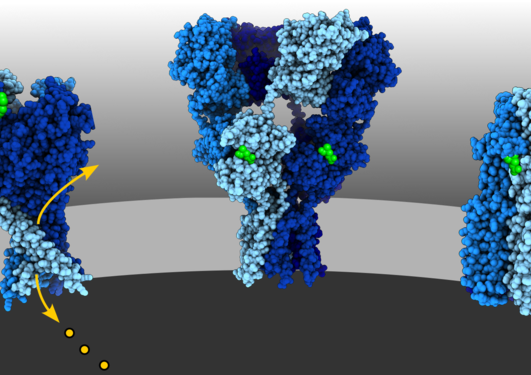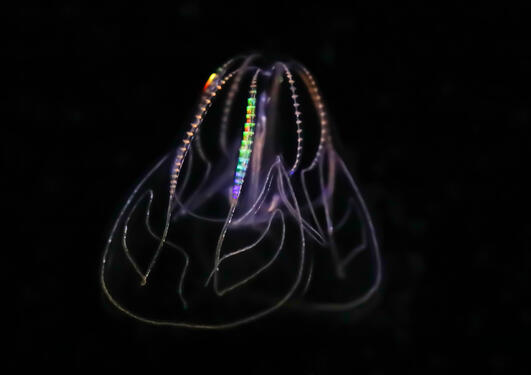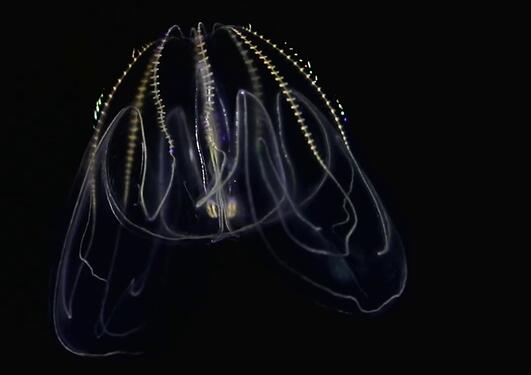Two Michael Sars Centre postdoctoral researchers awarded prestigious fellowships
Emily Claereboudt will pursue a project in chemical ecology after receiving a Marie Sklodowska-Curie Postdoctoral Fellowship, while Ruth Styfhals will lead a study on the developmental origin of nervous systems as part of an EMBO Postdoctoral Fellowship.

Main content
For early-career researchers, securing a fellowship is an incredible opportunity to pursue their scientific interests and build up their publication records for the future. It is a testament to their ability to ask relevant questions, and a recognition of their academic potential. “We are extremely proud of Emily and Ruth for winning these awards. These are strong testaments of the excellent research and training that we thrive for at Sars, and of the many opportunities that emerge from it”, celebrated Michael Sars Centre director Lionel Christiaen.
Hidden conversations on the sea floor
Emily became fascinated by the chemical ecology of sea cucumbers during her PhD, conducted in Belgium between the University of Mons and the University of Liège. After taking a break from sea cucumber research during her first year at the Michael Sars Centre, she is elated to reunite with her first scientific interest through a prestigious Marie Skłodowska-Curie Actions Postdoctoral Fellowship. “This is a huge opportunity for my career, massive”, she explained. “I'm really excited that I'm going to be working with my sea cucumbers again that I love and adore. But I'm also excited that I'm finally getting that recognition that I've been wanting for a while for my science.”
On the sea floor, sea cucumbers communicate by emitting molecules that help them defend themselves against predators, forage, find mates and favorable habitats to settle in. With the “Chemosensation in Holothuroids (SensHolo)” project, Emily’s goal is to shift the focus from the message to its reception. Using a range of behavioral, molecular and electrophysiological assays, she will characterize the receptors of messenger molecules in two local sea cucumber species, including the commercially exploited Norwegian red sea cucumber. As those chemical exchanges play a central role in reproduction, the results of the study are expected to be applicable to the emerging sea cucumber aquaculture in Norway. The animals will be maintained in the laboratory, adding to the range of organisms available for research at the Michael Sars Centre.
“Because it's so prestigious, it is a fellowship that is difficult to get, I'm hoping that it'll open a lot of doors in terms of what comes next for me”
- Emily Claereboudt
Emily has previously studied the evolution of ion channels in the group of Timothy Lynagh, and has recently started a project on chemical ecology in the ascidian Ciona with Marios Chatzigeorgiou. She underlines that both group leaders have been very supportive of her efforts to get funding for this new project, which will be conducted in close collaboration between the two laboratories. “Because it's so prestigious, it is a fellowship that is difficult to get, I'm hoping that it'll open a lot of doors in terms of what comes next for me”, Emily concluded. “I hope that’s setting me up for my career in academia.”

During her project, Emily hopes to establish the sea cucumber Labidoplax buskii in the laboratory (left). Ruth will work with the ctenophore Mnemiopsis Leidyi, here depicted at the larval stage.
Nerve net development in the first animals
When she joined the Burkhardt group at the Michael Sars Centre in 2023, Ruth had spent several years working on the development of the octopus brain for her PhD at the Stazione Zoologica in Naples and KU Leuven in Belgium. As she tried to understand how cephalopods have independently evolved a complex nervous system, she became curious about the very origin of neurons. Studying the first animals to have appeared on the planet was a logical choice for the next step of her career. “My interest really comes from studying cell type evolution, so then it's very interesting to study the development of these neurons in these early branching animals and see if we can learn something new”, she explained.
With the support of her EMBO Postdoctoral Fellowship, “Uncovering the developmental origins of the unique ctenophore nerve net”, Ruth will be investigating the cellular, molecular and regulatory basis of neural development in comb jellies. Rather than forming synapses to pass on information to each other, ctenophore nerve cells are arranged in a continuous net. How information is transmitted along the seemingly directionless system is unknown, and so is the development of this unique structure at the embryonic and larval stages. “It's really important work for all people that are interested in evolution and early branching species”, Ruth said. “We have no idea how a syncytial network develops, which I think is fundamental for all neuroscience to figure out how such a structure can evolve.”
“We have no idea how a syncytial network develops, which I think is fundamental for all neuroscience to figure out how such a structure can evolve.”
- Ruth Styfhals
Ruth credited both the scientific and financial freedom that she has access to in the Burkhardt group for her success in securing the fellowship. “Pawel gave me the time and support I needed to write this grant. I had time to familiarize myself with the model and gather preliminary results, which was a very luxurious position to be in”, she explained. The exciting study will rely on specimen availability, an opportunity offered by the Ctenophora facility at the Centre. “I think that the Michael Sars Center is the best place to do this research, because there's embryos every day”, she added. “Basically one of the only places in the world I can do this project!”



